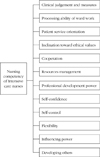Abstract
Purpose
This study was done to develop a nursing competency scale according to a clinical ladder system for intensive care nurses.
Methods
Index of content validation was done by 20 clinical experts and 80 nurses in Intensive Care Units (ICU).
Results
The process and results of study are as follows. First, 12 nursing competencies were used in the establishment of the clinical ladder system (Jang, 2000). Second, the first draft of the competency lists was developed. It was based on the clinical nurses' behavioral indicators of nursing competency by Jang (2000), and was modified and supplemented through various literature reviews including competency standards for specialist intensive care nurses in Australia and consultation with 2 clinical nurses with over 10 years experience in the ICU. Third, the draft was examined by 20 clinical experts for content validity. Finally, the final draft was analysed using clinical validity where 20 nurses in each ladder participated. The final number of items was fixed at 309.
Figures and Tables
References
1. Benner P. From beginner to expert: Excellence and power in clinical nursing practice. Menlo Park: Addison-Wesley;1984.
2. Benner P, Tanner C, Chesla C. From beginner to expert gaining a differential clinical world in critical care nursing. ANS Adv Nurs Sci. 1992; 14(3):13–28.
3. Buchan J. Clinical ladders: The ups and downs. Int Nurs Rev. 1997; 44(2):41–46.
4. Carper B. Fundamental patterns of knowing in nursing. ANS Adv Nurs Sci. 1978; 1(1):13–23.
5. Chinn PL, Kramer MK. Theory and nursing: A systemic approach. St. Louis: Mosby;1995.
6. Choi JS, Eun Y. A study on the clinical competence according to clinical ladder of operating room nurses. J Korean Acad Soc Nurs Educ. 2006; 12(1):60–69.
7. Corley MC, Farley B, Geddes N, Goodloe L, Green P. The clinical ladder: Impact on nurse satisfaction and turnover. J Nurs Adm. 1994; 24(2):42–48.
8. Dean-Baar SL. Application of the new ANA framework for nursing practice standards and guidelines. J Nurs Care Qual. 1993; 8(1):33–42. http://dx.doi.org/10.1097/00001786-199310000-00005.
9. Deckert B, Oldenburg C, Pattison KA, Swartz SL. Clinical ladders. Nurs Manage. 1984; 15(3):54–60.
10. Goodloe LR, Sampson RC, Munjas B, Whitworth TR, Lantz CD, Tangley E, et al. Clinical ladder to professional advancement program: An evolutionary process. J Nurs Adm. 1996; 26(6):58–64.
11. Gustin TJ, Semier JE, Holcomb MW, Gmeiner JL, Brumberg AE, Martin PA, et al. A clinical advancement program: Creating an environment for professional growth. J Nurs Adm. 1998; 28(10):33–39. http://dx.doi.org/10.1097/00005110-199810000-00008.
12. Hupcey JE. Feeling safe: The psychosocial needs of ICU patients. J Nurs Scholarsh. 2000; 32:361–367.
13. Jang BH. A study on critical care practice and development of standards for critical care nursing practice. Seoul, Korea: Yonsei University;2000. Unpublished master's thesis.
14. Jang KS. A study on establishment of clinical career development model of nurses. Seoul, Korea: Yonsei University;2000. Unpublished doctorial dissertation.
15. Kim DW. Modes on nursing care decision making in novice critical care nurses: Changes through experience. Seoul, Korea: Seoul National University;2001. Unpublished doctorial dissertation.
16. Kim GJ. The role of critical care nurses. Nursing life. 1991; 9:46–67.
17. Kim HY. A development of nursing competency for operating room nurses using a clinical ladder system. Gwangju, Korea: Chonnam National University;2005. Unpublished master's thesis.
18. Kwon EK. Evaluation of clinical competency weight and content validity of behavioral indicators for developing nursing performance appraisal. Inchun, Korea: Inha University;2001. Unpublished master's thesis.
19. Lee EO, Lim NY, Park HA. Nursing medical research and statistics. Seoul: Soomoonsa.
20. Lynn MR. Determination and quantification of content validity. Nurs Res. 1986; 35:382–386.
21. Park HO. A study on the analysis of performance appraisal tools for nurses. Seoul, Korea: Yonsei University;2001. Unpublished master's thesis.
22. Torstad S, Bjork IT. Nurse leaders' view on clinical ladders as a strategy in professional development. J Nurs Manag. 2007; 15:817–824. http://dx.doi.org/10.1111/j.1365-2934.2007.00769.x.
23. Woodrow P. Nursing perspectives for intensive care. Intensive Crit Care Nurs. 1997; 13:151–155.
24. Youk SY. Nursing competency and indicator development by emergency nurse's clinical ladder. J Korean Acad Nurs Adm. 2003; 9:481–494.




 PDF
PDF ePub
ePub Citation
Citation Print
Print




 XML Download
XML Download